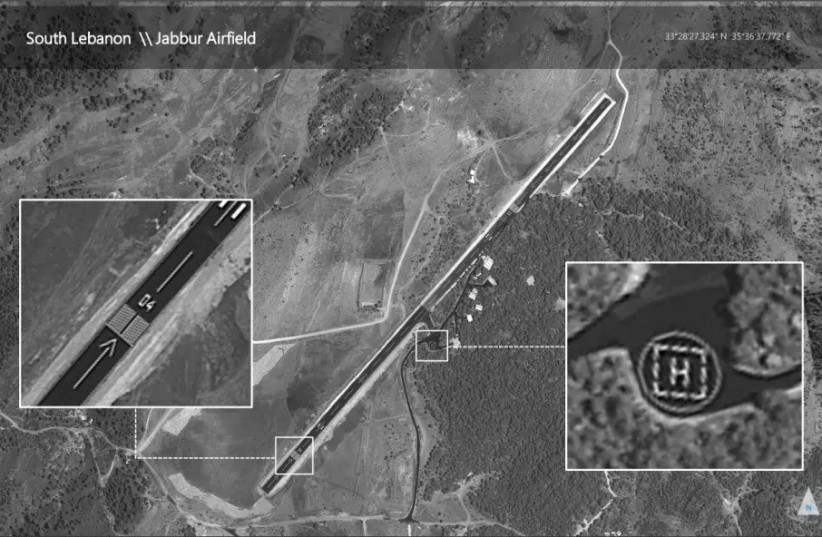The IDF on Thursday attacked a key Hezbollah-Iranian airstrip in Kilat Jaber, Lebanon, that was used for launching aerial attacks against Israel, in a major escalation between the sides.
Last September, Defense Minister Yoav Gallant revealed pictures showing the joint Hezbollah-Iranian terrorist air base in southern Lebanon, about 20 kilometers from the Israeli border.
The Iranian flag could be seen flying on the runways at the terrorist air base, which the ayatollahs’ regime is using to plot against Israel, he said at the time.
“Put differently, the land is Lebanese, the control is Iranian, the target is Israel,” Gallant said.
Israel must “remain aware and at [the] ready, with our eyes set on the binoculars and our fingers on the trigger,” he said.

Iran remains the greatest threat to Israel, although it sometimes uses Hezbollah and other proxies to fight its wars against the Jewish state, Gallant said.
If Hezbollah “goes toward a conflict with us, they will pay a high price,” he said.
“We will not allow Iran to turn Syria into a Hezbollah 2.0” with powerful rockets, Gallant said.
Previous IDF strikes
Last week, The Jerusalem Post was present when top defense officials were asked about when the base would be struck, and they dropped hints that such an attack might not be far off, without committing to any timeframe.
The IAF also attacked a series of Hezbollah targets in the areas of Tzur and Ma’ira in Lebanon.
Earlier Thursday, Hezbollah launched two “hostile aerial objects” into Israel that fell harmlessly near Kfar Blum, the IDF said in extremely vague terms regarding whether the military’s defenses had functioned properly.
In addition, the IDF attacked other Hezbollah locations in Lebanon using artillery and mortars.
There were no rocket sirens in the North on Thursday, and as of press time, Hezbollah had not yet responded to the IDF’s major power move against its air strip.
Meanwhile, Gallant visited the Yahalom anti-tunnel unit on Thursday, praising them for their success in destroying Hamas tunnels and trapping terrorists within their own supposed booby-trap they set for IDF forces.
Hamas was collapsing within its own tunnels, he said.
For the first time, large numbers of Hamas forces, more than 100, were starting to surrender in Khan Yunis, the way some large numbers started to surrender eventually in northern Gaza, Gallant said.
If the trend continues, it would be a major development after nearly two months of fighting in southern Gaza. The IDF had been more frustrated with Hamas’s ability to hold out much longer in Khan Yunis than the terrorist group had held out in Gaza City.
The IDF sent out several additional messages about focused progress in Khan Yunis on Thursday, but IDF sources were still unclear how close the terrorist group’s remaining battalions there were to breaking the way they have in northern Gaza.
Also, IDF sources are sending less clear messages now than last month about whether Hamas’s leadership remain in Khan Yunis and are close to being surrounded, or whether they may have fled to Rafah or some other part of southern Gaza where the IDF still has largely not entered.
As of press time, the only rocket siren for Thursday was midday at Nahal Oz, which also marked the first rocket fired by Hamas since Monday and only the third in more than a week.
Overall, total rocket sirens in both the North and the South have fallen to 44 for the last week, or only about six per day, down from hundreds per day at the start of the war and even 50-70 per day months into the war.
IDF Chief of Staff Lt.-Gen. Herzi Halevi held a situational assessment with other top officers and reservists in Khan Yunis on Thursday.
Following the assessment, he expressed his “massive appreciation” for reservists operating on the ground in Gaza, telling troops that they were carrying out “historically significant” operations against the enemy, “with the number of problems per square kilometers... the level of fighting was extremely high.”
Regarding IDF reservists who were withdrawn from Gaza this week, Halevi said: “Even when everyone is out [of Gaza], they must be taken care of, and after they are taken care of, we will resume fighting.”
Jerusalem Post Staff contributed to this report.
